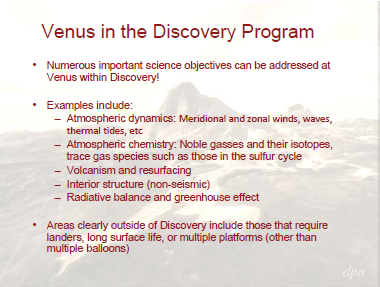

In a previous blog entry, I discussed the quandaries that scientists focusing on the inner planets (ex Mars) face. That seems especially true for Venus science. First, Venus is just plain hard to study: the atmosphere is opaque except for a few narrow spectral bands and the surface is literally hell that requires advanced engineering to even reach, much less to operate on for several hours. In addition, many of the easy missions have been done. The basic radar mapping was completed in the 1990s. ESA's Venus Express and Japan's upcoming orbiter address the obvious atmospheric questions. The next steps in Venus exploration will require highly capable orbiters with advanced radars or difficult to design and test landers. The only easy missions left that I'm aware of are balloons to float in the upper atmosphere for long term chemical and dynamics studies. (In this, Venus is one of the easier planets to study since its dense atmosphere makes balloons extra buoyant, although there are the problems of designing the deployment system and surviving air laced with sulfuric acid.)
Despite these challenges, Venus is a world ripe for study because it is the only other large terrestrial planet in the solar system (Mars and Mercury being substantially smaller). Understanding why Venus ended up so different from Earth is likely to tell us a lot about how terrestrial worlds operate.
The U.S. Venus science community is advocating a $3+B flagship mission for the 2020s that would involve a sophisticated orbiter, two landers that could survive for a day to make in-depth analysis of surface samples, and two balloons. The technology for this mission is not yet ready, and NASA is already committed to two to three flagship class missions for the coming decade between Mars and Jupiter-Europa. So for this decade, the request is for the technology development that would enable this mission to be ready for selection a decade hence.
In the meantime, the Venus science community would like to see one or more Discovery (~$450M) and New Frontiers (~$650M) missions sent to the evening star. In the former category, the community lists several concepts. (As an editorial aside, I'll note that a number of Venus Discovery missions have been proposed, but none selected. It's not clear what is necessary to break this track record.) In a previous blog entry, I discussed a number of New Frontiers mission concepts. One of those has been described in more detail in a White Paper, and I'll describe it in more detail in the next blog entry.
Editorial Thoughts: For this blog entry, I'll close with a couple of observations. It appears that the VEXAG (an advisory group of Venus scientists) would prioritize a Venus atmospheric probe/lander as its highest New Frontiers priority, a balloon mission as its second highest priority, and a radar mapper as its third priority. All of these capabilities are included within the concept of Russia's Venera D mission for mid to late this decade. From what I can tell, Venera D is in the early planning stages and the Russian's are seeking international participation. One approach to NASA participation would be to provide one or more of the elements within these three concepts. I expect that Russia would prioritize a lander that builds on its history of Venus landers as something it will do in house. The French, with their expertise in balloons and experience with the Vega balloons, might contribute the balloon portion. NASA could contribute the orbiter. All partners could contribute instruments to each platform.
Should this kind of cooperation not be possible, then if NASA and Russia both build one or more landers, then Venus is a big and varied place. Eventually, we'll need a number of landers to understand its story.
Resources:
Venus VEXAG justification for exploring Venus and mission priorities (from a Decadal Survey meeting)
Venus Flagship mission concept (from a Decade Survey meeting)
Summary of New Frontiers mission concepts (from this blog)
Venus New Frontiers lander concept (from this blog)
Venus balloon concept and a Discovery mission concept (from this blog)


No comments:
Post a Comment